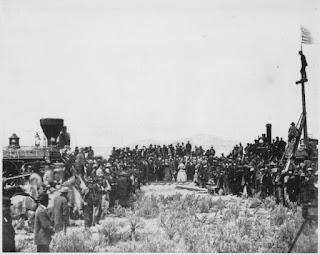The “nineteenth century internet” might not impress
middle-grade students today, but it provided the first means of transmitting
messages around the world in virtually real-time. This marvelous invention, which
eventually evolved into the present-day internet, was the telegraph. Between these
two mass-communication methods came the telephone, radio, television,
computers, and satellites. When I was a middle-grade student and an active member of the Boy Scouts of America, one of the skills we strove to learn was Morse Code. Even after I went into the US Army in 1960, telegraphic systems were used to send messages around the world. The story of the evolution of communications is told
nicely by Janice Parker in Messengers, Morse Code, and Modems.
In the early 1800s, several inventors, most notably in
England, were experimenting with harnessing the power of electricity in order
to send a signal over a wire. But the generally accepted “inventor” of a
successful telegraph system is American painter Samuel F. B. Morse. He had been
fascinated with the study of electricity as a youth, but it was not until he
reached middle age that he embarked seriously on the idea of creating the
telegraph. At the age of 41, after studying art in France, Morse sailed back
home in 1832. Conversations with fellow passengers about the possible ways of
using electricity to aid communications stimulated his interest. He immediately
went to work on the endeavor that resulted in successfully demonstrating his
invention at the United States Supreme Court in 1844. The message he tapped out
to prove the telegraph could work is well known to American school children:
“What hath God wrought?” A good biography of Morse’s life and work is contained
in The Invention of the Telegraph and Telephone in American History by Anita
Louise McCormick.
The Morse Code system of dots and dashes fascinated politicians,
newspaper reporters, and railroad operators, who quickly took advantage of this
speedy way of communicating. During the Civil War both the Union and the
Confederate armies used the telegraph to control movements of troops and
supplies. President Abraham Lincoln was a strong advocate of the new electric system of
communication. He spent hours in the telegraph office of the War
Department, across the street from the White House, receiving reports from the
battlefields and sending orders to his commanders. President Lincoln, Willie Kettles, and the Telegraph Machine by Marty Rhodes Figley tells the story of the youngest telegraph operator in the War Department.
When the threat of a Civil War increased in 1860, the only
means of communication between the contiguous states on the east coast and the
new states of Oregon and California on the west coast was via mail delivered
cross-county by stagecoach or sent onboard ships around Cape Horn, South
America. From April 1860 to October 1861 the Pony Express shortened the
delivery time of mail from weeks to less than ten days. But all the time the
Pony Express was operating between St. Joseph, Missouri, and Sacramento,
California, workers hurried to stretch a telegraph line across the intervening
prairies and mountains. With the transmission of the first telegram from
California’s Chief Justice to President Lincoln in October 1861, the Pony
Express died. Now, a message could travel in a matter of minutes almost anywhere
in the country.
The original cross-country telegraph line followed the route
of the overland stagecoach. When President Lincoln signed the Pacific Railroad
Act of 1862 on July 1 of that year, the construction program included a
telegraph line to parallel the railroad. When the Union
Pacific joined with the Central Pacific at Promontory Summit, Utah, on May 10, 1869,
cross-country stagecoach travel ended, and telegraph traffic switched to the
new lines adjacent to the iron rails. One of the most famous transmissions via the telegraph to
reach all points around the country, and even points in Europe via the recently completed undersea cable, was “Done.” That simple message signaled the driving of the golden spike and the completion of the first transcontinental railroad. Andrew J. Russell's famous photograph shows a spectator standing
on the crossbeam of the telegraph pole above the ceremony.
I write
about this historic telegraphic event in Golden Spike, The Iron Horse
Chronicles—Book Three. This book is yet to be published, but the first two
books in my trilogy (Eagle Talons and Bear Claws) contain numerous scenes
depicting the important use of the first “internet” as work progressed to
extend the railroad from Omaha, Nebraska, to Sacramento, California, in the late 1860s.





Great precursor to the internet!
ReplyDelete